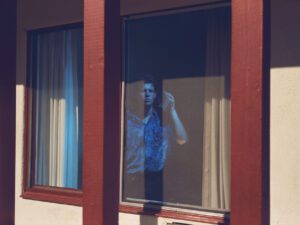It is 1952 and the austerity of a long and keenly felt war is being shrugged off tentatively. It’s effect on Parisians can still be glimpsed here and there – in the lost gaze of a street urchin or a pile of rubble where an abandoned building used to be. Yet there are also lovers in cafés; butchers hard at work with meat aplenty; and well-dressed ladies taking in a sunset by the Seine. These and more are the striking scenes of ordinary life in a city that would never be the same again – but that would still remain timeless in its unique way. It is this Paris that celebrated mid 20th century photographer Henri Cartier-Bresson captures with both an insider’s warmth and a visitor’s measured eye. Running 24 April – 29 August at The Sainsbury Centre for the Arts on the University of East Anglia campus, the exhibition features new prints of Cartier-Bresson’s photographs of Paris in the 1950s and 1960s.
Although running as it does in tandem with the Centre’s main exhibition – A Line Through Time: Alberto Giacometti – this modest collection of evocative photos both holds its own through the power of its images, and for the very fact that Cartier-Bresson photographed Giacometti at work, bringing a little of both exhibitions to seep into one another. Indeed, the former was in many artistic circles before he began working largely with photography: he was influenced by his socialising with the Surrealists of Paris in the early 1920’s, inspired by their allowing subconscious thoughts and visions to dictate the direction of their creation.
Although he painted and continued his interest in art when studying at Cambridge, it was his experiments with a camera – given to him by an American soldier he met on duty in France in 1929 – that, he felt, were expressive of the vision he had been unable to bring forth on canvas. That was the start of a long and remarkable life and career; from escaping a Nazi prison camp and founding Magnum Photos soon after in 1947, to his photojournalism in the Far East in the 1970s. In that sense, the exhibition here gives little about the scope and variety of his work and life.
However, when it comes to Paris – as is the focus of this exhibition, granted – a memorable and evocative impression of the city and out photographer’s affinity towards it becomes apparent. Most striking are Cartier-Bresson’s observations of the gritty, real Paris; although the shots that now feel familiar to us of the City of Lights feature here and there, it is the truly spontaneous shots, in keeping with his conviction that seeing and immortalising The Decisive Moment is the key to practising modern photography, that made this modest mezzanine-level exhibition, perhaps rather trapped between the mammoth Giacommetti and the Sainsburys’ permanent collection, very much worth a look.
Butch sailors staring at he camera in defensiveness; a young, busy mother passing over the baby to her husband; Sartre smoking a cigarette by the Seine; a boy proudly grinning on his way home from the shops, clutching the spoils of this grown-up errand. The images stay in mind long after, bringing the textures of mid-century Paris to life; it is little surprise Cartier-Bresson was known as the photographer of the street, but what is striking is his enduring ability to reveal the beauty and authenticity in the mundanities of city life.
Sarah Jilani
Shown in the UK for the first time, Henri Cartier Bresson: Paris is organised by Magnum Photos and the Fondation Henri Cartier-Bresson. It runs until 29 August 2016 at The Sainsbury Centre, Norwich. http://scva.ac.uk
Credits:
1. Cristian Dior fashion show. (1957) © Henri Cartier-Bresson/Magnum Photo. Courtesy of Sainsbury Centre for Visual Arts, Norwich.





